VW gee! The protein powerhouse you need in your kitchen
Because blobs of gluten can be super tasty…honestly!
Sounds like the beginnings of a horror novel, but seitan crept up on me. I was aware of the amazing ‘ fake meats’ you get all across Asia, but didn’t really know how they were made — until I discovered ‘vital wheat gluten’ or VWG, and all the ways of cooking it.
British vegan takeaways selling fake kebab meat still confuse me as to how they make it taste SO GOOD, but I’ve picked up some top tips and tricks — and great recipes, of course, over the last decade or more since I started playing with VWG.
WTF is VWG?
I really can’t be bothered with this process, but I will try it one day…
It’s basically the gluten part of flour. You can wash — and wash, and wash — flour dough to get it to turn into the gluteny—gloop, but I’m a bit lazy and more inclined to just buy the processed stuff. The process of making it at home is akin to washing sushi rice. A tedious repetitive act that feels like a punishment!
Anyway, as I said in the intro, seitan (Say-tan) crept up on me. I think I discovered it was a ‘vital’ ingredient in making fake meats about 10 or 15 years ago, and I haven’t looked back since. In fact, I bought a giant 5kg sack of it and I’ve been wading through that for about a year…
You take some VWG, mix it with spices, flavourings and water and/or broth, and then steam it or bake it. It’s that simple, and is fundamentally the same basis of most processed supermarket ‘meats’ you care to mention.
It packs waaaay more protein than steak, contains bucket loads more iron, calcium and selenium than steak, and has zero cholesterol.
In fact, VWG boasts approximately 75g of protein per 100g, surpassing both tofu and steak, making it an excellent food source for those seeking high protein.
With minimal fat and carbohydrates, VWG is suitable for low-fat and moderate-carb diets, and while it provides significant amounts of iron and selenium, it’s lower in calcium compared to tofu.
BUT…VWG lacks lysine, an essential amino acid, so it's beneficial to pair it with lysine-rich foods like legumes to ensure a complete amino acid profile, and aid digestion.
Data sourced from USDA and related nutritional databases.
People in the UK seem to be going wild for Juicy Marbles steaks, which for me, look a little too much like the real thing. And of course, because of my ‘I can probably make that at home’ attitude — and the fact that two steaks (226g) are selling for a whopping £9, I created a recipe that’s kind of similar, using VWG, which creates two bigger steaks (about 150g each), costing just £1.36 for two, not £9 (according to Chat GPT, I’m shit at maths). But hey, the packaging’s fancy, right? 😊 See below for the recipe.
Look at the ingredients of a Juicy Marbles steak (and good on them, I say!) “Water, Soy Protein Concentrate (27%), Sunflower Oil, Natural Flavours, Red Beet Juice Concentrate, Thickeners (Carrageenan, Methylcellulose), Vitamin B12” The biggest ingredient, as you probably know, is listed first.
Soy Protein Concentrate is different to Soy Protein Isolate, which is more powdery, doesn’t contain as much fibre as concentrate, and leaves you with a ‘steak’ more akin to a wobbly lump of tofu. You can, by all means, use isolate instead of concentrate, but you’ll need (at least) to add VWG and oil to get a more appropriately chewy meat-style texture.
Who discovered it?
VWG is sometimes called "wheat meat" because of its chewy, meat-like texture after cooking. Seitan has been a traditional protein source for centuries, particularly in East Asian cuisines, where Buddhist monks used it as a meat alternative.
I think it’s vital as in important, because I like it, but the vital bit of the name is actually referring to the fact that the gluten is still active – or ‘vital’. “Vital” means the gluten is still active — it retains its ability to form an elastic network when hydrated and kneaded. i.e. - it’s chewy.
In contrast, if gluten is heated, it loses this elasticity and becomes useless for dough formation.
Anyway, I digress. While seitan (VWG) is relatively new to me, it’s actually been around for more than 1400 years. Vital wheat gluten has a long and fascinating history that traces back to ancient China, over 1,400 years ago. It was first developed by Buddhist monks, who sought plant-based alternatives to meat as part of their vegetarian diets. These monks discovered that by washing wheat dough under water, they could rinse away the starch and be left with a sticky, elastic mass — pure gluten. This gluten was called miàn jīn (面筋), which translates to "wheat muscle" in Chinese, perhaps a fitting name given its fibrous, chewy texture that closely mimicks meat.
I’m quite anti-subscription, and keen to keep this newsletter accessible to all, but it takes a while to make. So if you’d like to support me with a virtual coffee, which will keep me in VWG, do click here and throw me a few pieces of silver… That's HERE. THANKS!
The use of gluten was deeply tied to spiritual and philosophical values. For Buddhist monks, maintaining a meatless diet was important for ethical and religious reasons, but they still desired substantial, satisfying foods. Wheat gluten offered a way to recreate the mouthfeel of meat without harming animals, aligning perfectly with Buddhist principles.
1,000 years ago, Buddhist monks were probably chowing down on these sausages.
The form they used back then was fresh gluten, typically steamed, boiled, or fried after washing. It was the same substance as what we know today as vital wheat gluten, but without modern industrial drying and powdering processes.
The term "seitan" was introduced much later. In the 1960s, Japanese health advocate George Ohsawa (an ahead of his time kinda guy, who also invented the macrobiotic diet and the natural food movement, apparently) brought the concept to the West, calling it "seitan," a word that loosely translates to "made of protein" in Japanese. His version helped popularise wheat gluten among Western vegetarians and health-conscious eaters.
If you read about him (Wikipedia link above), you’ll realise the online abuse vegans get today pales into insignificance compared to what Ohsawa went through…it’s your duty to eat seitan in his honour, people!
Mr. Seitan, George Ohsawa, a man ahead of his time
The modern form of vital wheat gluten powder - the dry, shelf-stable version we buy today - is a product of industrial refinement. In factories, gluten is separated from wheat flour using mechanical methods, then dried carefully to preserve its elasticity. This drying is crucial: it keeps the gluten "vital".
While the powder form is modern, the basic technique of extracting gluten from wheat dates back to ancient Chinese kitchens and temples.
So, there you go, the low down on Seitan. And once you’ve mastered making it (and I so recommend Sam Turnbull’s course), you can use it in so many ways — curries, stir fries, Sunday roasts, sandwiches, pies, kebabs…it’s endless.
And I’m sorry I haven’t shared anything for celiacs or gluten-free people, I’m saving that for another complete newsletter!
Enjoying this read so far? Phew, I’m so glad…why don’t we make this more official?
RECIPES
Emulating a 'Juicy Marbles' Steak at Home


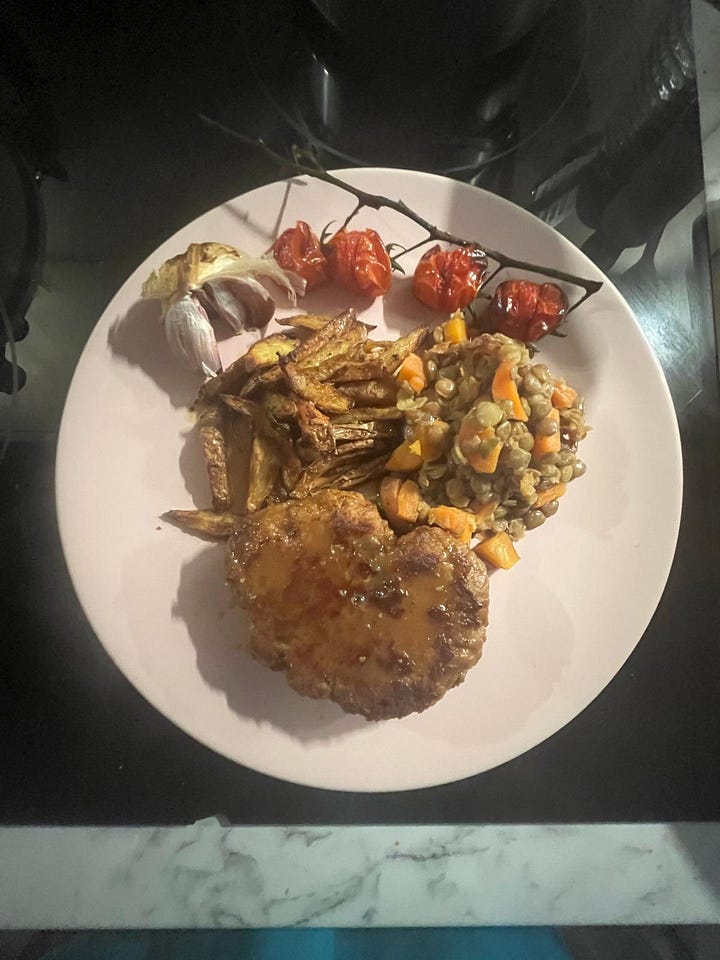
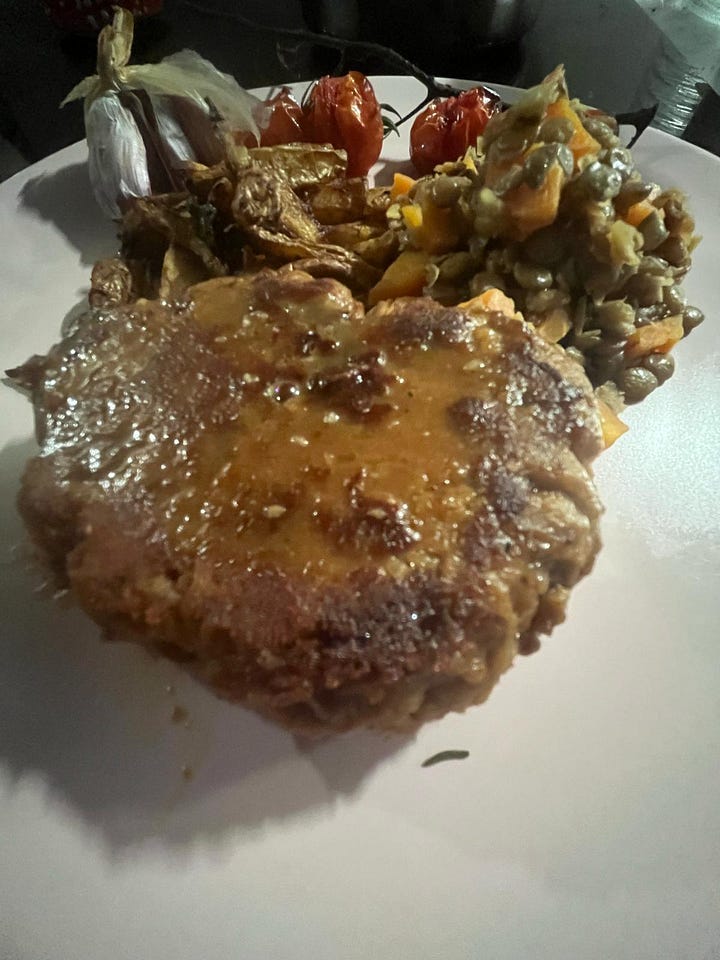
The seitan steak cooking process, from the raw pieces of ‘steak’, steaming, plated and a sexy close up. Mine, we agreed, were a bit too thick (like me)
I think this recipe admirably replicates the texture and flavour of a 'Juicy Marbles' plant-based steak. Feel free to add in your own spices, ramp up the amounts, or leave stuff out you don’t fancy. The key to it all is texture, and I find the kneading (more like massaging, really) therapuetic. I’ve included weights, because, as Sam Turnbull testifies, amounts are important for good seitan.
Ingredients (for ~300g finished steak)
1 cup Vital Wheat Gluten (~120g)
3/4 cup Water or Vegetable Broth (~180g)
2 tablespoons Soy Sauce (~30g)
1 tablespoon Nutritional Yeast (~8g)
1 teaspoon Garlic Powder (~2.8g)
1 teaspoon Onion Powder (~2.4g)
1 tablespoon Olive Oil (~13.5g)
½ teaspoon of balsamic vinegar
½ teaspoon Kappa-Carrageenan (~1.5g)
½ —1 teaspoon Beet Powder (for colour)
Preparation
In a large bowl, combine the Vital Wheat Gluten, Nutritional Yeast, Garlic Powder, Onion Powder, and the Kappa-Carrageenan (very important: mix it dry to avoid clumping).
In another bowl, mix Water or Vegetable Broth, Soy Sauce, Olive Oil, balsamic vinegar and the optional beet juice or beet powder for a red meat-like hue.
Pour the wet ingredients into the dry mixture. Stir quickly until a dough forms.
Knead gently for about 2–5 minutes to develop elasticity (don't over-knead or it will get rubbery).
Divide dough into 2 portions (~150g each) and shape into thick steak-like slabs (~2cm thickness).
Steam the Steaks for 30 minutes over medium heat.
Let them rest afterward (at least 5 minutes) to firm up fully.
Heat a pan with a small amount of oil. Sear your steamed steaks for 1–2 minutes per side until a golden-brown crust forms.
Top Tips
Kappa-Carrageenan strengthens texture and enhances water retention, giving a "juicy" chew, but if you don’t have it, don’t worry too much, they’re still pretty good.
Use oil in your steamer dish, as it tends to stick. To add to densty, you can tightly wrap the steak patties in baking / parchement paper or foil, but I don’t think it’s necessary.
Resting after steaming is crucial for setting the internal structure.
Marinate optionally after steaming for even more flavour depth (soy sauce, garlic, liquid smoke, paprika blends, etc). It needn’t be overnight, but I sat mine in some broth I coked lentils in, with extra soy, garlic granules and a dash of mapple syrup. As I fried them, I kept basting them in this liquid, too. You want them to be moist.
Seitan and Vegetable Stir-Fry (Buddhist Monk Style)
This recipe acknowledges seitan’s ancient history, through a nod to traditional temple cuisine (shojin ryori), which is plant-based, peaceful, and nourishing. Many Buddhist monks prefer very light seasoning - feel free to reduce soy sauce or skip garlic if you want it to be even closer to traditional Zen temple cooking.
Shojin ryori often emphasises seasonal, local ingredients. You can swap in whatever vegetables are fresh and available.
Eating mindfully is part of the experience. I recommend taking time to appreciate your food’s origin and nourishment, rather than wolfing it down over an episode of Better Call Saul, which is what I seem to be doing lately…
When I grow up, I want to be Saul Goodman
Ingredients:
200g seitan, sliced or ripped into bite-sized pieces
1 medium carrot, julienned
1 small courgette/zucchini, sliced
1 small bunch bok choy or 100g spinach
1 tablespoon sesame oil
2 tablespoons soy sauce
1 tablespoon mirin or 1 teaspoon agave syrup
1 teaspoon freshly grated ginger
1 small garlic clove, minced (optional)
2 tablespoons water or vegetable broth
1 teaspoon toasted sesame seeds
1 serving of cooked brown or white rice, or your grain of choice
Preparation:
Marinate the seitan in 1 tablespoon soy sauce and 1 tablespoon water for about 10 minutes.
Heat the sesame oil in a large skillet or wok over medium heat.
Sauté the ginger and optional garlic until fragrant.
Add the marinated seitan and stir-fry until lightly browned, about 3 to 5 minutes.
Add the carrot and courgette/zucchini and stir-fry for 2 minutes.
Add the bok choy or spinach and pour in the remaining 1 tablespoon soy sauce, mirin (or agave), and 2 tablespoons water or broth.
Cook, stirring gently, until the vegetables are tender but still bright, about 2 to 3 minutes.
Sprinkle with toasted sesame seeds and serve hot over the cooked rice.
Quick & Flavourful Steamed Seitan
An old insta post from me says it all…
This is my go to recipe for a basic seitan, quicker and even easier than the ‘steak’ above. It’s infintely customisable, and you can chop, rip, bake, stir fry or generally muck about with it in as many ways as you wish. Make Ohsawa proud!
Ingredients:
1 cup vital wheat gluten
3 tablespoons nutritional yeast
1 teaspoon garlic powder
1 teaspoon onion powder
1 teaspoon smoked paprika (optional but recommended)
3/4 cup vegetable broth
2 tablespoons soy sauce
1 tablespoon olive oil
1 teaspoon apple cider vinegar (or rice vinegar)
1 teaspoon maple syrup or agave (optional, balances flavour)
Preparation:
In a large bowl, whisk together the vital wheat gluten, nutritional yeast, garlic powder, onion powder, and smoked paprika.
In a separate bowl, mix the vegetable broth, soy sauce, olive oil, apple cider vinegar (or rice vinegar) and maple syrup or agave.
Pour the wet ingredients into the dry ingredients and stir until it forms a shaggy dough.
Knead lightly for about 1 minute until it just comes together — don’t over-knead.
Divide the dough into two or three pieces and shape into rough ovals or patties.
Wrap each piece loosely in foil or baking parchment, twisting the ends like candy. You don’t need to do this, but it does create a firmer batch.
Set up a steamer basket over simmering water, place the wrapped seitan inside, cover, and steam for 20-30 minutes, flipping halfway if possible.
Let cool slightly, then unwrap and slice, tear, or fry as needed!
Bonus Tip: After steaming, you can marinate it quickly in soy sauce, a dash of sesame oil, and a splash of vinegar for even more punch before cooking it in your dish. It does better if you give it a few hours to firm up in the fridge, so make it ahead, or make it and store it in the fridge.
Turkish-Style Seitan Kebab Meat
Our Easter meal in Turkiye - at Vegan Food Cartel
We’re just back from a week in Istanbul, which over the years has become one of my favourite cities. It’s such a massive foodie place, and I honestly think there are few places like it, where every second doorway is an eatery. We went out of our way to find a joint that did vegan kebabs, and it was worth it. Inspired by that restaurant, and my circle of Setain-ic heroes: Sam Turnbull, The Buddhist Chef, Gaz Oakley, and my own adaptations from traditional Turkish kebab spice profiles, here’s a recipe that you might find you keep going back to (and tweaking).
Ingredients:
1 cup vital wheat gluten
2 tablespoons chickpea flour
3 tablespoons nutritional yeast
1 teaspoon smoked paprika
1 teaspoon ground cumin
1 teaspoon ground coriander
1 teaspoon garlic powder
1 teaspoon onion powder
1/2 teaspoon ground cinnamon (a key Turkish spice)
1/2 teaspoon chili flakes or Aleppo pepper (traditional Turkish flavour)
3/4 cup vegetable broth
2 tablespoons soy sauce
1 tablespoon olive oil
1 tablespoon tomato paste (Gaz Oakley trick: adds depth and umami)
1 teaspoon apple cider vinegar
1 teaspoon maple syrup or agave (optional but rounds the spices)
Preparation:
In a large bowl, whisk together the vital wheat gluten, chickpea flour, nutritional yeast, smoked paprika, cumin, coriander, garlic powder, onion powder, cinnamon, and chili flakes.
In another bowl, whisk the vegetable broth, soy sauce, olive oil, tomato paste, apple cider vinegar, and maple syrup until smooth.
Pour the wet ingredients into the dry ingredients and stir with a spatula until it forms a dough.
Knead lightly for about 1 minute to bring it together, but do not overwork it.
Divide the dough into 2 pieces, shape into rough thick logs or small loaves.
Wrap each piece loosely in foil or parchment paper and twist the ends.
Steam in a steamer basket over simmering water for 35 minutes, flipping halfway through if you can.
Let cool slightly, unwrap, and then slice thinly or tear into strips for the kebab.
For maximum flavour, quickly pan-fry the strips in a little olive oil and extra pinch of cumin and paprika before serving.
TIP: If you want it even more döner-like, after steaming, layer seitan strips tightly in a loaf tin, bake at 180°C for 15 minutes to crisp the edges, then shave pieces off with a knife when serving. (inspired by Gaz Oakley’s Vegan Döner Kebab method.)
Quick Turkish-Style Seitan Marinade
Bung this on your döner meat…and be happy.
Ingredients:
2 tablespoons olive oil
1 tablespoon soy sauce
1 tablespoon tomato paste
1 teaspoon apple cider vinegar (or lemon juice for a lighter taste)
1/2 teaspoon ground cumin
1/2 teaspoon smoked paprika
1/4 teaspoon ground coriander
Pinch of chili flakes or Aleppo pepper
Optional: 1/4 teaspoon garlic powder (for extra punch)
Preparation:
Whisk everything together in a small bowl until smooth.
Brush generously over sliced or torn steamed seitan while pan-frying, grilling, or baking.
Keep brushing lightly as it cooks so it soaks into the seitan and forms a shiny, delicious glaze.
Pro Tip: After brushing the marinade on, press the seitan into the hot pan for a few seconds without moving it — this gives those tasty little charred crispy edges, just like real street kebab meat. (Sam Turnbull and Gaz Oakley both love this technique in their recipes.)
That’s all folks! Please share your Seitanic adventures, I’d love to see what you make, and how it turns out!







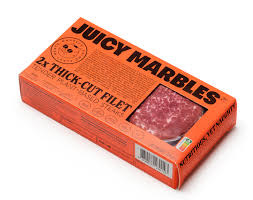


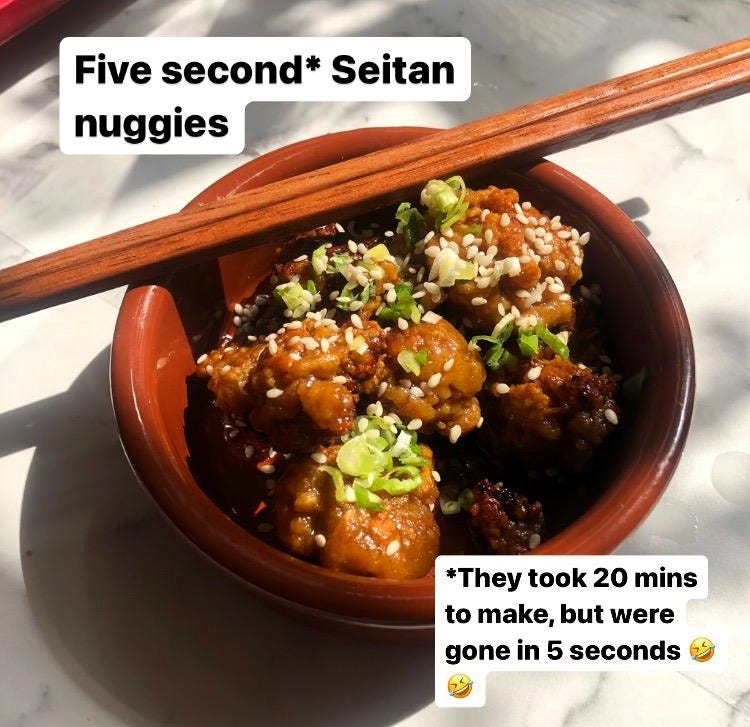
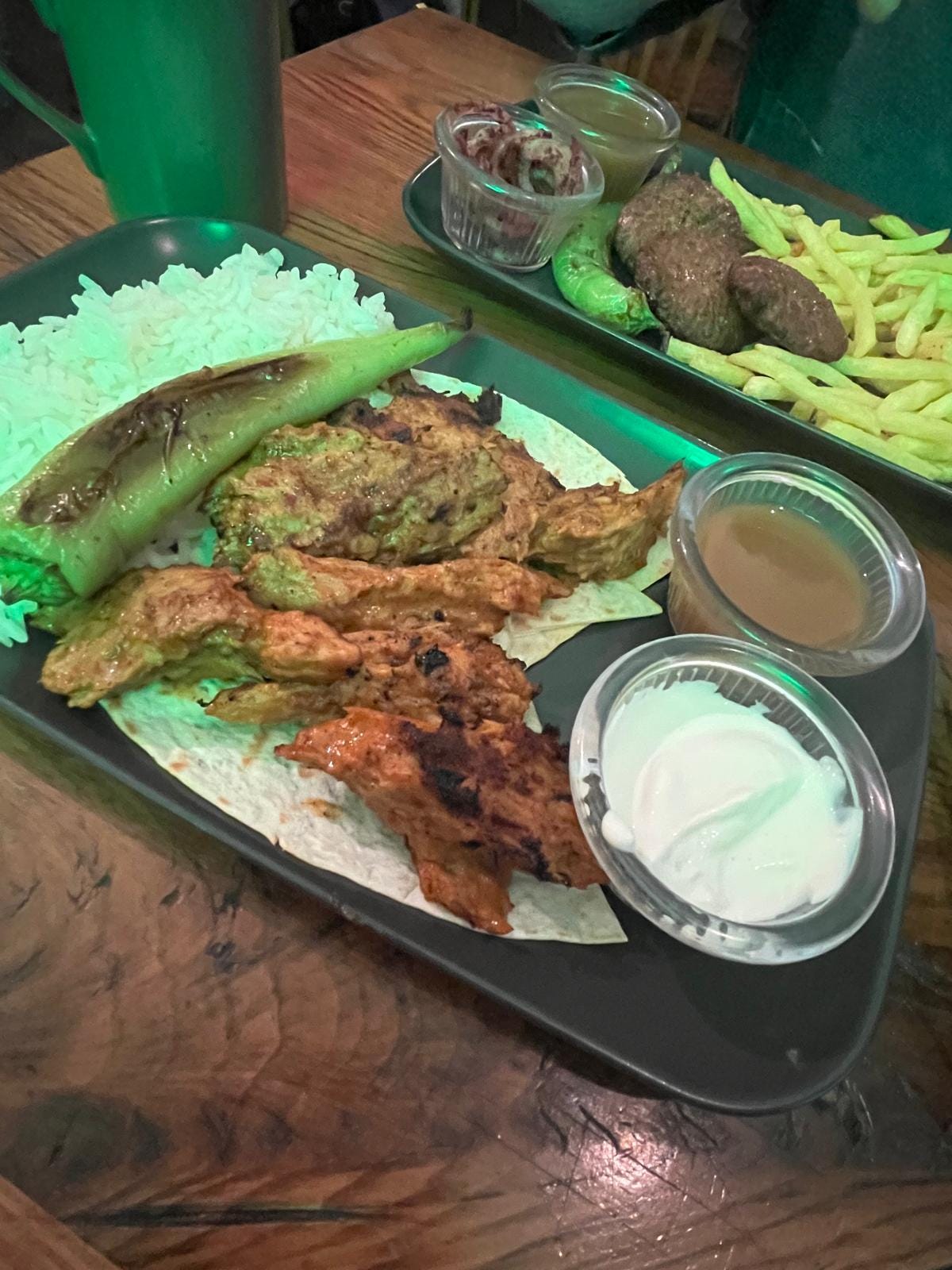
These sound absolutely fabulous! I want to make something but am, at the moment, in court waiting for my case to be called. But I can dream can’t I? Fake Steak! Phony Baloney! Cheap and delicious and healthy. What’s not to like?